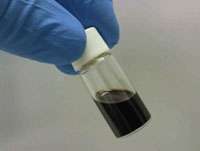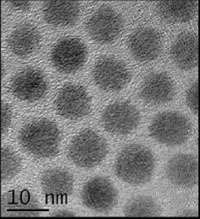Breakthrough advances nanomaterials for printable solar cells

An RMIT University research collaboration with top scientists in Australia and Japan is advancing next generation solar cells.
The development of cheaper and less toxic solar cells using nanotechnology is the focus of a collaborative research project conducted by RMIT, CSIRO and the Japan Science and Technology Agency.
The team is investigating the synthesis of semi-conductor inorganic nanocrystals using low-cost and abundant elements for printable solar cell applications.
The research was recently published in the high-impact Journal of the American Chemical Society.
The RMIT research team is led by Professor Yasuhiro Tachibana from RMIT's School of Aerospace, Mechanical and Manufacturing Engineering.
"The focus of photovoltaic industries has been to reduce material and production costs for photovoltaic panels," Professor Tachibana said.
"As a result research into next generation solar cells has been of significant importance as it concentrates on developing novel low cost and low toxicity colloidal nanomaterials in order to meet industry requirements."
Colloidal nanocrystals can be used as an "ink", enabling solar cells to be quickly and cheaply fabricated with a printer.

Currently, cadmium or lead elements dominate colloidal nanocrystals synthesis, despite toxicity concerns.
The research team – which includes Dr Joel van Embden from the School of Aerospace, Mechanical and Manufacturing Engineering, and Professor Kay Latham from the School of Applied Sciences – has been exploring alternative elements to synthesise nanocrystals.
Dr van Embden said: "Synthesising entirely new nanocrystals was one of the most challenging tasks, since the initial reaction conditions are unknown.
"We have focused on incorporating the elements, copper and antimony, into nanocrystals, as they are low-cost, low-toxic and earth-abundant," he said.
In its research, the team has discovered the novel selective synthesis of tetrahedrite and famatinite copper antimony sulphide (CAS) nanocrystals.
Both nanocrystals display a brown-blackish colour with strong absorptions of visible and near-infrared light, suitable as a light absorber in solar cells.
The colloidal nanocrystal solutions (semiconductor nanocrystal inks) can readily be employed to prepare thin nanocrystal films.
Professor Tachibana said nanocrystal films could be fabricated on an electrode and applied to photovoltaic devices, thin-film thermoelectrics and transistors at a comparatively low cost compared with other methods.
The team has already confirmed electricity generation is possible from the nanocrystalline film under light.
Journal of the American Chemical Society, a weekly peer-reviewed scientific journal that publishes original research papers in all fields of chemistry, is the highest ranked journal in this field.
Professor Xinghuo Yu, Director of the RMIT Platform Technologies Research Institute, said the publication in the high-impact journal was an indication of the high standard of research conducted by the institute's researchers.
"The institute brings together multi-disciplinary teams of academics to undertake high-impact industry-focused projects to solve complex research questions of national and global significance," Professor Yu said.
"The collaboration between the researchers at the School of Aerospace, Mechanical and Manufacturing Engineering and School of Applied Sciences has produced this successful outcome to benefit industry and the community."
Journal information: Journal of the American Chemical Society
Provided by RMIT University


















